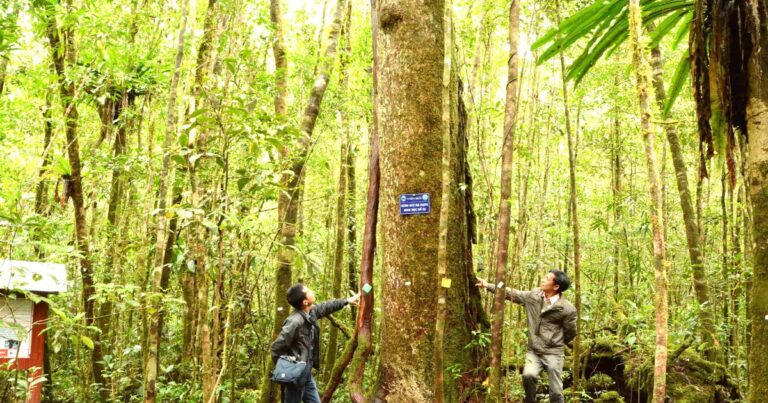With existing forests, many places in the Central Highlands are looking forward to exploiting their natural resources.
Bidoup Nui Ba National Park
Vietnam implemented projects to transfer 5.15 million forest carbon credits to Emergent – a non-profit organization established to urgently address the climate and biodiversity crises by encouraging the reduction of deforestation to deliver climate benefits , maximizing the ecosystem and sustainable development – and accelerating the reduction of emissions through forest financing (LEAF) at $10 per tonne from 2022 to 2026 in 11 provinces in the South Central and Central Highland regions. This is a positive signal for the carbon market in Vietnam and also an opportunity and expectation for sustainable forest development.
With the existing forest area, many places in the Central Highlands are looking forward to digging a big gold mine from natural resources. Director Hoang Sy Bich of the Ministry of Agriculture and Rural Development of Lam Dong Province said that Lam Dong Province is currently jointly with ten provinces in the Central Highlands and South-Central regions (including Dak Nong, Dak Lak, Gia Lai, Kon Tum ) Tum, Quang Ngai, Binh Dinh, Phu Yen, Khanh Hoa, Ninh Thuan, Binh Thuan) coordinates with the Ministry of Forestry and relevant parties to finalize the procedures for the allocation of carbon credits for natural forests, as a basis for the sale of carbon credits for natural forests through the LEAF/Emergent organization.
For the current human-planted forests, no organization or country has registered to implement the documents and procedures for Lam Dong Province to obtain carbon credits for planted forests as a basis for carbon credit sales. In the near future, the Ministry of Agriculture and Rural Development of Lam Dong Province will contact the Ministry of Agriculture and Rural Development, the Ministry of Forestry and relevant sectors and organizations on procedures for granting carbon credits for planted forests to generate income for forest owners and many stakeholders, Mr. Hoang Sy Bich added.
Kon Tum Provincial People’s Committee Vice Chairman Nguyen Huu Thap said that with a forest area of 616,000 hectares, there is great potential for the province to build carbon credits. Forest carbon credits are an emerging issue and are considered a sustainable financial source to support localities and forest owners in carrying out the tasks of forest management, protection and development, and forest fire prevention. However, there are no specific instructions for implementation.
Therefore, the Provincial People’s Committee has requested the government, ministries and responsible agencies to issue specific instructions for implementation, especially in the areas of purchasing and selling mechanisms, management and use of financing sources. Similarly, Gia Lai Provincial Forest Protection Department deputy director Truong Thanh Ha said the area has a forest area of more than 649,000 hectares spread across 17 districts, towns and cities. The provincial Ministry of Agriculture and Rural Development is also actively working with the Ministry of Forestry to develop a carbon credit project in the province.
Mr. Ha also shared that for the planted forest area, Ecotree Company is currently proposing a number of issues related to research to cooperate in investing in planting and developing sustainable forests and establishing a pilot project for carbon credits for planted forest areas. Ecotree Company has completed the research and is completing documents and specific proposals. After Ecotree Company completes the specific proposal file, the Provincial Department of Agriculture and Rural Development will cooperate with the relevant departments to work with the Provincial People’s Committee on the company’s proposal.
However, Mr Ha added that specific instructions and regulations should come from the government. The Ministry of Agriculture and Rural Development will work with relevant departments to advise the Provincial People’s Committee on implementation.
Following the results of the carbon credit project for 11 central highlands and south-central provinces, many forest owners in the central highlands are currently ready to approach the new project. Director Khuong Thanh Long of Ta Dung National Park in Dak Nong Province said the Ta Dung National Park Management Board has used resources and improved the capacity of National Park Management Board staff to implement the reward for future carbon credit services. Notably, by the end of 2023, the unit will have planted more than 620 hectares of new forest. Forest development on barren land areas has helped increase carbon reserves for Ta Dung National Park.
Dak Nong Provincial People’s Committee Vice Chairman Le Trong Yen also has expectations about the forest carbon market. He said Dak Nong province is expected to issue carbon credits in 2025, earning an estimated $10 per credit. According to Deputy Director Phan Viet Ha of the Central Highlands Institute of Agriculture and Forestry Sciences, carbon credits are one of the solutions to restore forests in the Central Highlands.
Currently, resources for managing, protecting and developing forests are limited, even though forests provide many ecological and ecological services. Building a market for forest carbon credits will create economic means for forest owners, businesses, people and foresters to invest in forest protection and development.
If Vietnam’s forest carbon credit market develops well, it will be an opportunity for development toward sustainable economic, social and environmental management of forests. Therefore, authorities should create favorable conditions in terms of mechanisms and laws to encourage units and people to build carbon credits in the forests, said Mr. Phan Viet Ha.
By Staff Writers – Translated by Anh Quan


